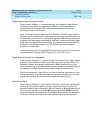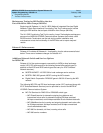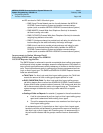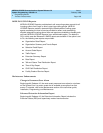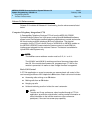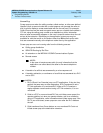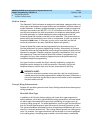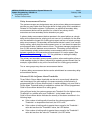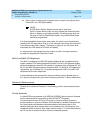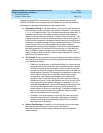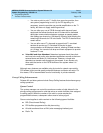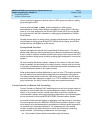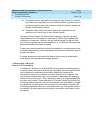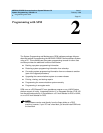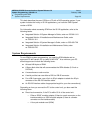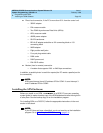
MERLIN LEGEND Communications System Release 6.0
System Programming
555-660-111
Issue 1
February 1998
Programming Basics
Page 1-74Product Enhancements
1
■ If the number of waiting calls is greater than or equal to the highest value,
Threshold 3, the LED lights steadily.
NOTE:
A DSS (Direct Station Selector) button that is used as a
Calls-in-Queue Alarm button can only indicate two threshold levels,
either by flashing or by lighting steadily. If a calling group must use
this type of Calls-in-Queue Alarm button, only two threshold levels
should be programmed.
If all three thresholds are set to the same value, the result is one threshold only
(steady) with LED state either off or on. If two values are the same, then the result
is two alarm levels (flash, steady). The factory is setting is one call for all three
thresholds with LED states of off, flash, and steady.
An external alert only signals when the number of calls in the queue meets or
exceeds the programmed Threshold 3 value.
MLX-5 and MLX-5D Telephones 1
The MLX-5 nondisplay and MLX-5D display telephones are compatible with all
system releases. The display telephone includes a 2-line by 24-character display,
and both telephones come with 5 line buttons. In systems prior to Release 5.0, the
MLX-5 and MLX-5D telephones are treated as MLX-10 and MLX-10D telephones
respectively. As of Release 5.0, the system recognizes the MLX-5 and MLX-5D
telephones as 5-button telephones.
If these telephones are connected to communications system releases prior to
5.0, they are recognized by the communications system as 10-button telephones.
Release 6.0 Enhancements 1
Release 6.0 includes all Release 5.0 functionality, plus the enhancements listed
below.
Private Networks 1
In Hybrid/PBX mode systems only, MERLIN LEGEND Communications Systems
can be networked with one another or with DEFINITY
®
Enterprise
Communications Server (ECS) and ProLogix
™
Communications Systems in
private networks. In previous releases, this functionality is available using tie lines,
but users handle calls between networked switches as outside calls. In this
release, dialing the pool access code is not necessary for a call going from one
networked switch to another. Also, delay-start tie trunks or T1 trunks administered
as PRI can act as
tandem trunks
to connect networked systems.



